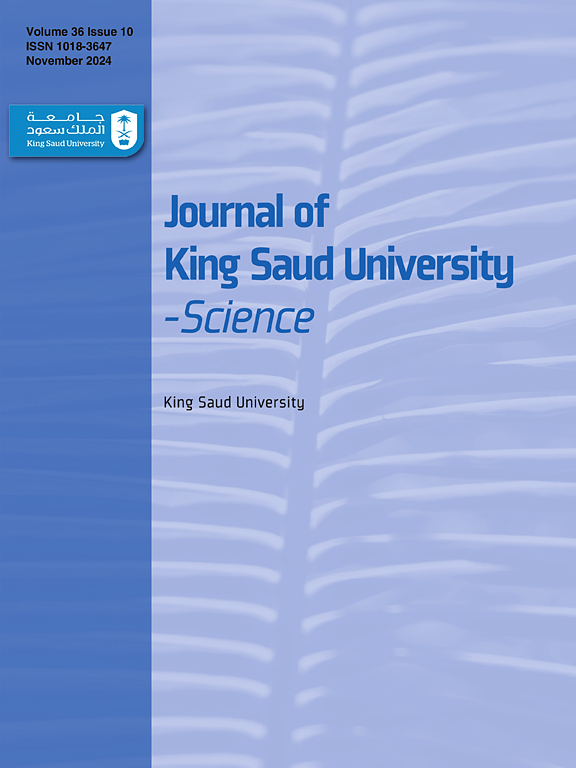The discovery and simulation analysis of a novel mutation c.40 G < T (V14F) in the NRAS gene in patients with colorectal cancer in Saudi Arabia
IF 3.7
3区 综合性期刊
Q1 MULTIDISCIPLINARY SCIENCES
引用次数: 0
Abstract
Background
Colorectal cancer (CRC) is the most diagnosed cancer in men and the second most common cancer in women and remains associated with high morbidity and mortality in Saudi Arabia. The current understanding of genetic heterogeneity of CRC biology encourages the identification of the genetic causes of CRC in the Saudi population.
Methods
In this study, we obtained 89 CRC patients’ tumor samples from Saudi Arabia and investigated the molecular alterations of the NRAS proto-oncogene, GTPase (NRAS) gene in the collected CRC tumor tissue samples to identify gene mutations using DNA sequencing using an automated DNA sequencer ABI 3730xl. The impact of mutations was analyzed using different bioinformatics tools including SwissModel, Missense3D, molecular dynamics simulations using YASARA DYNAMICS and Protein Variation Effect Analyzer (PROVEAN) tool.
Results
We identified a novel mutation c.40 G > T, in one patient in whom valine was replaced by phenylalanine (V14F). Notably, we also identified another mutation in the same codon c.40 G > A where valine is replaced by isoleucine (V14I). Our in-silico analysis revealed that this novel mutation alters the binding affinity of the NRAS gene substantially, and as a result, could have lethal consequences on the downstream signaling genes and pathways including MAPK and PI3K involved in regulating CRC growth and progression.
Conclusions
These findings provide insights into the molecular etiology of CRC in general and particularly in the Saudi population. Thus, these findings in NRAS mutation testing may also guide further treatment modalities, and more personalized therapy may be optimized.
沙特阿拉伯结直肠癌患者 NRAS 基因中 c.40 G < T (V14F) 新型突变的发现与模拟分析
背景在沙特阿拉伯,结直肠癌(CRC)是男性诊断率最高的癌症,也是女性诊断率第二高的癌症,而且发病率和死亡率居高不下。方法在这项研究中,我们从沙特阿拉伯获得了 89 例 CRC 患者的肿瘤样本,并使用 ABI 3730xl 自动 DNA 测序仪进行 DNA 测序,调查了所收集的 CRC 肿瘤组织样本中 NRAS 原癌基因 GTPase(NRAS)基因的分子改变,以确定基因突变。我们使用不同的生物信息学工具分析了基因突变的影响,包括 SwissModel、Missense3D、YASARA DYNAMICS 分子动力学模拟和 Protein Variation Effect Analyzer (PROVEAN) 工具。值得注意的是,我们还在同一密码子 c.40 G > A 中发现了另一个突变,其中缬氨酸被异亮氨酸取代(V14I)。我们进行的室内分析表明,这种新型突变大大改变了 NRAS 基因的结合亲和力,因此可能对参与调控 CRC 生长和进展的下游信号基因和通路(包括 MAPK 和 PI3K)产生致命影响。因此,这些 NRAS 基因突变检测结果还可指导进一步的治疗方法,并优化更多的个性化疗法。
本文章由计算机程序翻译,如有差异,请以英文原文为准。
求助全文
约1分钟内获得全文
求助全文
来源期刊

Journal of King Saud University - Science
Multidisciplinary-Multidisciplinary
CiteScore
7.20
自引率
2.60%
发文量
642
审稿时长
49 days
期刊介绍:
Journal of King Saud University – Science is an official refereed publication of King Saud University and the publishing services is provided by Elsevier. It publishes peer-reviewed research articles in the fields of physics, astronomy, mathematics, statistics, chemistry, biochemistry, earth sciences, life and environmental sciences on the basis of scientific originality and interdisciplinary interest. It is devoted primarily to research papers but short communications, reviews and book reviews are also included. The editorial board and associated editors, composed of prominent scientists from around the world, are representative of the disciplines covered by the journal.
 求助内容:
求助内容: 应助结果提醒方式:
应助结果提醒方式:


